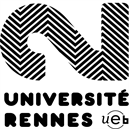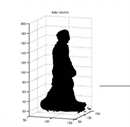

Franck Multon
Professor University Rennes 2 - Inria
2011

Gait analysis with multiple depth cameras. E Auvinet, F Multon, J Meunier. Engineering in Medicine and Biology Society, EMBC, Annual International Conference of the IEEE
The gait movement seems simple at first glance, but in reality it is a very complex neural and biomechanical process. In particular, if a person is affected by a disease or an injury, the gait may be modified. To help detecting such change, we propose a new method based on multiple depth cameras. The aim of this paper is to show the possibility to reconstruct the body 3D volume in real time during gait in order to detect a pathological problem related to this movement and eventually improve diagnosis. Preliminary results showed that the system is sensitive to gait change produced by a heel prosthesis (heel cup) inserted in one shoe of subjects walking on a treadmill. The system detected a difference between maximal forward and backward positions of lower limbs for this pathological walk, a difference that was negligible for normal walk. These promising results were obtained with only 3 low cost depth cameras; we therefore believe that such methodology opens a new and affordable way for 3D volumetric gait analysis.
The gait movement seems simple at first glance, but in reality it is a very complex neural and biomechanical process. In particular, if a person is affected by a disease or an injury, the gait may be modified. To help detecting such change, we propose a new method based on multiple depth cameras. The aim of this paper is to show the possibility to reconstruct the body 3D volume in real time during gait in order to detect a pathological problem related to this movement and eventually improve diagnosis. Preliminary results showed that the system is sensitive to gait change produced by a heel prosthesis (heel cup) inserted in one shoe of subjects walking on a treadmill. The system detected a difference between maximal forward and backward positions of lower limbs for this pathological walk, a difference that was negligible for normal walk. These promising results were obtained with only 3 low cost depth cameras; we therefore believe that such methodology opens a new and affordable way for 3D volumetric gait analysis.
Fall detection with multiple cameras: An occlusion-resistant method based on 3-d silhouette vertical distribution. E Auvinet, F Multon, A Saint-Arnaud, J Rousseau, J Meunier. Information Technology in Biomedicine, IEEE Transactions on 15 (2), 290-300
According to the demographic evolution in industri-alized countries, more and more elderly people will experience falls at home and will require emergency services. The main problem comes from fall-prone elderly living alone at home. To resolve this lack of safety, we propose a new method to detect falls at home, based on a multiple cameras network for reconstructing the 3D shape of people. Fall events are detected by analyzing the volume distribution along the vertical axis, and an alarm is triggered when the major part of this distribution is abnormally near the floor during a predefined period of time, which implies that a person has fallen on the floor. This method was validated with videos of a healthy subject who performed 24 realistic scenarios showing 22 fall events and 24 cofounding events (11 crouching position, 9 sitting position, and 4 lying on a sofa position) under several camera configurations, and achieved 99.7% sensitivity and specificity or better with four cameras or more. A real-time implementation using a graphic processing unit (GPU) reached 10 frames per second (fps) with 8 cameras, and 16 fps with 3 cameras.
According to the demographic evolution in industri-alized countries, more and more elderly people will experience falls at home and will require emergency services. The main problem comes from fall-prone elderly living alone at home. To resolve this lack of safety, we propose a new method to detect falls at home, based on a multiple cameras network for reconstructing the 3D shape of people. Fall events are detected by analyzing the volume distribution along the vertical axis, and an alarm is triggered when the major part of this distribution is abnormally near the floor during a predefined period of time, which implies that a person has fallen on the floor. This method was validated with videos of a healthy subject who performed 24 realistic scenarios showing 22 fall events and 24 cofounding events (11 crouching position, 9 sitting position, and 4 lying on a sofa position) under several camera configurations, and achieved 99.7% sensitivity and specificity or better with four cameras or more. A real-time implementation using a graphic processing unit (GPU) reached 10 frames per second (fps) with 8 cameras, and 16 fps with 3 cameras.

A Motion-based User Interface for the Control of Virtual Humans Performing Sports. X Liang, Z Wang, W Geng, F Multon. International Journal of Virtual Reality 10 (3), 1-8
Traditional human computer interfaces are not intuitive and natural for the choreography of human motions in the field of VR and video games. In this paper we present a novel approach to control virtual humans performing sports with a motion-based user interface. The process begins by asking the user to draw some gestures in the air with a Wii Remote. The system then recognizes the gestures with pre-trained hidden Markov models. Finally, the recognized gestures are employed to choreograph the simulated sport motions of a virtual human. The average recognition rate of the recognition algorithm is more than 90% on our test set of 20 gestures. Results on the interactive simulation of several kinds of sport motions are given to show the efficiency and interestingness of our system, which is easy-to-use especially for novice users.
Traditional human computer interfaces are not intuitive and natural for the choreography of human motions in the field of VR and video games. In this paper we present a novel approach to control virtual humans performing sports with a motion-based user interface. The process begins by asking the user to draw some gestures in the air with a Wii Remote. The system then recognizes the gestures with pre-trained hidden Markov models. Finally, the recognized gestures are employed to choreograph the simulated sport motions of a virtual human. The average recognition rate of the recognition algorithm is more than 90% on our test set of 20 gestures. Results on the interactive simulation of several kinds of sport motions are given to show the efficiency and interestingness of our system, which is easy-to-use especially for novice users.



